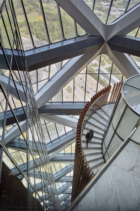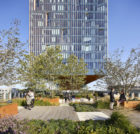China Poly Group asked us to design a flagship development for Beijing’s Dawangjing district, a new hub for global business in China’s capital city. The main tower should not only become a landmark in this promising business district, it must also be tailored to the geography and climate of Beijing—a region prone to earthquakes, pollution, and extreme seasonal weather.
From its construction, to its environmental impact, to its user experience, Poly International Plaza needed to embody all of the hallmarks of top-quality architecture. We assembled an interdisciplinary team of architects and engineers to meet this challenge with a holistic, integrated building design.
With a faceted design inspired by traditional Chinese paper lanterns, the tower’s structural system is based on the “diagrid,” or diagonal grid system. Beyond meeting seismic requirements and climate conditions, this design framework is the cornerstone of the building’s sustainability performance, as well as its distinguishing trait in the Beijing skyline.


Refined since its invention over a century ago, the diagrid is a highly efficient engineering solution: it can be built with less material than other structural systems, and it creates open, column-free interior spaces. Poly International Plaza continues SOM’s tradition of innovation in diagrid design, beginning with San Francisco’s Alcoa Building (1967) and Chicago’s John Hancock Center (1970). Our structural engineers adapted the building technology for Beijing’s climate and seismic conditions, achieving the tower’s curved form with straight structural members.
The glass-enclosed steel exoskeleton is just one of two building envelopes. A second, interior glass envelope creates a soaring, 400-foot-high atrium space—nearly the entire height of the 31-story skyscraper. This interstitial space mediates exterior temperature extremes, reducing the overall building energy consumption by 23 percent and carbon emissions by 18 percent. By allowing the tower to be naturally insulated and cooled, this building-within-a-building approach is the key to the project’s sustainable design.


The long-span diagrid structure achieves two big benefits at once: an energy-efficient building envelope and a column-free interior filled with daylight. If traditional Chinese paper folding patterns provided the inspiration for the form, it was the concerted effort of an integrated architecture and engineering team that has put the iconic building on track for LEED Gold certification. What’s more, the atria and open floor plates make room for inviting social spaces, from shared lounges to a roof garden, that help to build a sense of community among the people who work in the building.
Completed in 2016, the building stands as a testament to the power of collaborative, integrated design. As critic Alexandra A. Seno summed up in Architectural Record, “Instead of competing with other buildings in terms of superlatives—height, price, or spectacle—Poly and SOM created a tower that stands out as a technological achievement and a distinctive landmark in a booming new district of the city.”



